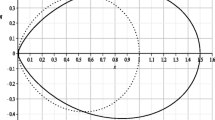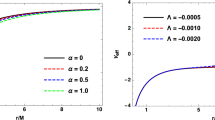Abstract
If really such objects like cosmological black holes exist they may be studied with a standard technique like strong and weak gravitational lensing. Cosmological voids can be explained as the result the collapse of large perturbations into black hole with masses of the order of 1014 M ⊙ and the expansion of the universe. The resulting image of the universe is that it is more homogeneous than expected from present observations. In this paper we discuss some lensing properties related to the cosmological black holes (CBHs), namely we consider differences in gravitational lensing for point like mass and extended mass distributions. We consider the singular isothermal sphere model as a toy (illustrative) model for an extended distribution of dark matter and a slightly more complicated isothermal sphere with a core.
Similar content being viewed by others
References
P. J. E. Peebles, “The void phenomenon,” Astrophys. J. 557, 495–504 (2001).
C. Stornaiolo, “Cosmological black holes,” Gen. Rel. Grav. 34, 2089–2099 (2002).
C. Capozziello, M. Funaro, and C. Stornaiolo, “Cosmological black holes as seeds of voids in the galaxy distribution,” Astron. Astrophys. 420, 847–851 (2004).
M. Serpico, R. D’Abrusco, G. Longo, and C. Stornaiolo, “Cosmological black holes as voids progenitors: simulations,” Gen. Rel. Grav. 39, 1551–1562 (2007).
A. Einstein, “Lens-like action of a star by the deviation of light in the gravitational field,” Science 84, 506–507 (1936).
P. Schneider, J. Ehlers, and E. E. Falco, Gravitational Lenses (Springer, Berlin, 1992).
A. F. Zakharov, S. Capozziello, and C. Stornaiolo, “Gravitational lensing properties of cosmological black holes,” in Gravitation, Astrophysics, and Cosmology, Proceedings of the 12th Asia-Pacific International Conference, Moscow, June 28–July 5, 2015 (World Scientific, Singapore, 2016), pp. 367–368.
Author information
Authors and Affiliations
Corresponding author
Additional information
The article is published in the original.
Rights and permissions
About this article
Cite this article
Zakharov, A.F., Capozziello, S. & Stornaiolo, C. Gravitational lens models for cosmological black holes. Phys. Part. Nuclei Lett. 14, 416–418 (2017). https://doi.org/10.1134/S1547477117020352
Received:
Published:
Issue Date:
DOI: https://doi.org/10.1134/S1547477117020352




